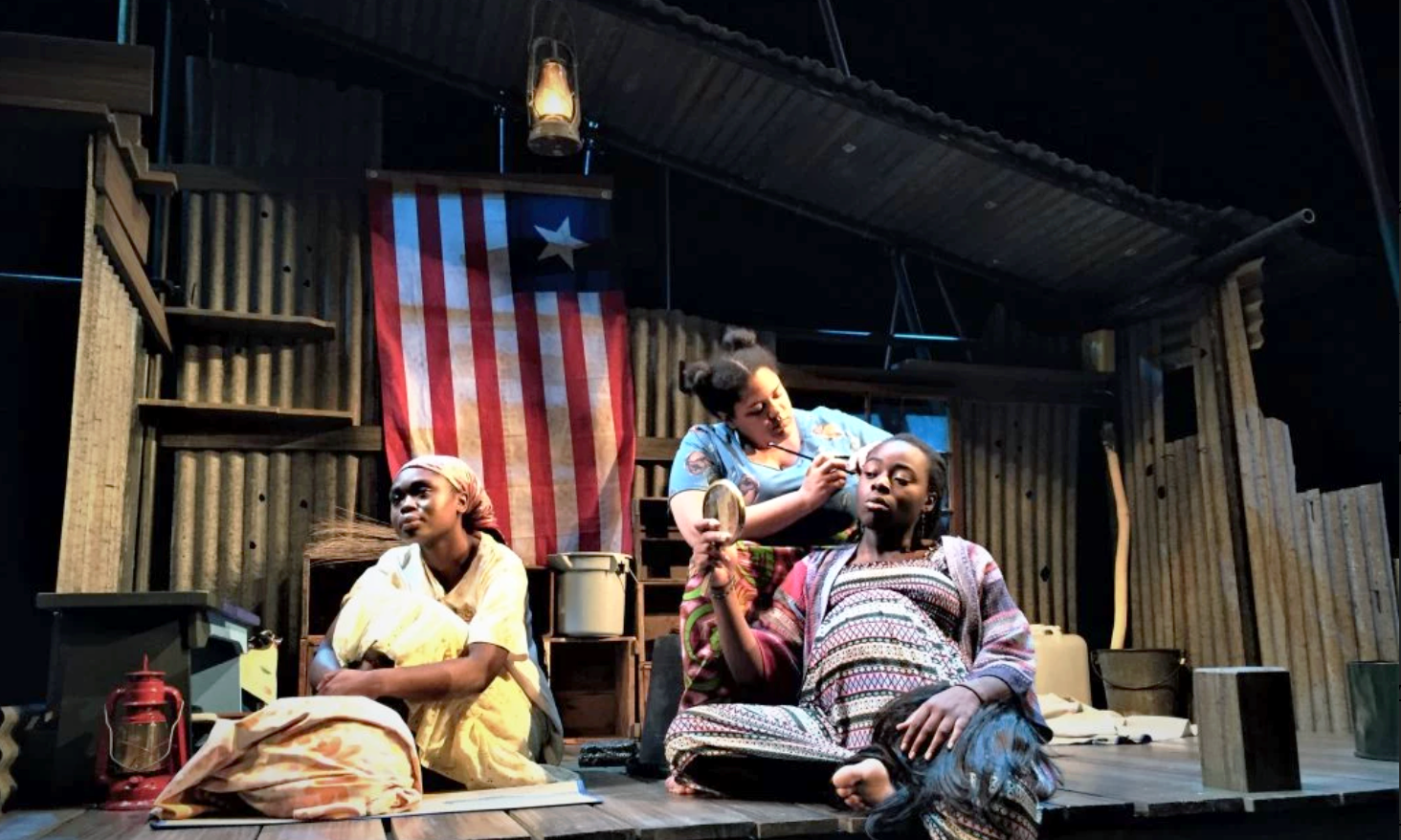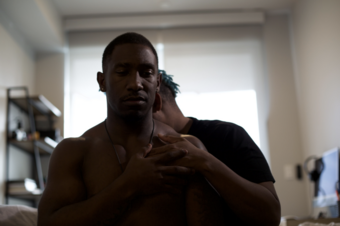As I learned more about the places and spaces for developing as a director, suggestions to seek out opportunities directing in colleges and universities always came up in conversation. The benefits for me as a director were attractive: solid money, good resources for design, the chance to work on classics and/or contemporary plays, eager students, and no reviews. It would also provide the opportunity for real-time exploration of craft, voice, and collaboration. For each academic directing job booked, I rallied my community and networks to the performances, finally getting myself out of that dreadful, classic catch-22: you can’t get a gig because you haven’t had significant enough samples of work, but you need significant samples of work to get a gig.
Twice, at two different liberal arts colleges—both with predominantly white faculties—I was offered to direct a new play written by a person of color for the mainstage. While I was thrilled by the chance to work with their students of color, I was also familiar with the traditional demographics of liberal arts theatre programs. I asked the schools, “How did your department come to this programming decision and are you prepared to accurately cast the play?” Both of the schools said, “Yes, absolutely. We are ready.” But in both cases, not enough students auditioned for the roles called for.
I was expected to provide a semester-long solution for a generational, institutional failure, and I had 25 percent less rehearsal and preparation time than expected, added emotional exhaustion, and pressure on me to make sure the production turned out okay.
Though I was a near stranger to these communities, I was called upon to recruit. I was connected to affinity groups, clubs, and the football and basketball teams to inquire about students who might want to do a play. Current students, some of whom were auditioning for the plays themselves, were also called upon to help recruit. This created added emotional and administrative labor on my part as a guest; I was being depended on to help navigate the politics of academic institutions and speak on the behalf of the white professors scrambling for a solution.
Ultimately, both times we could not cast the original plays. I had to brainstorm new ones. Since I’d been hired to direct the “diversity” play of each school’s season, the replacement plays had to be written by a person of color. I know this because, in one of the experiences, I pitched Rhinoceros by Eugene Ionesco and the department chair replied, “Not quite.” The replacement plays had to have enough roles for the students who had already auditioned, to honor their time spent waiting to hear back on a final casting decision. I needed plays I could pull together with little preparation and that could fit into what time was left in the production calendar. Twice, my months of pre-production preparation for the original play was useless, and I scrambled to prepare to direct a few different titles we had requested from the licensing company. In both instances, I lost rehearsal hours and even a chunk of my budget since set and costume building on the previous play had already commenced. I was asked to proceed with business as usual.
As a young, Black, queer director and newcomer, there were already so many ways I was in the hot seat. On top of that, though, in both cases I was expected to provide a semester-long solution for a generational, institutional failure, and I had 25 percent less rehearsal and preparation time than expected, added emotional exhaustion, and pressure on me to make sure the production turned out okay. More than anything, I felt the need to show up for the young theatre artists of color who were thrilled that I was there, come to save them from their all-white departments. If I had had a “me”—a mentor who looked like me, talked like me, or hurt like me—how different would my sense of a future have been? I wanted to share my journey with the students, provide guidance and commonality. And we were able to build very meaningful bonds. Today, I am still in contact with the majority of them. I write their recommendation letters, edit their artistic statements, bring them to my rehearsals, hire them. I hold space for them over the phone or text when they feel their department or professors are erasing them.
The dissonance between what liberal arts programs wish to accomplish by articulating their commitment to equity and inclusion, and what work they are actually ready to engage in, is evident in their inability to make space for people of color as their students and as invited guest artists. Liberal arts theatre programs are failing their students of color and we need to start a dialogue about it. Here are four concrete things that colleges and universities can adopt as a place to start.
Liberal arts theatre programs are failing their students of color and we need to start a dialogue about it.
1. Expand the notion of “the canon.”
Our academic and aesthetic definition of the canon is incredibly dated, which is at the expense of anyone who does not identify as cis, white, male, middle class, able-bodied and/or college educated. It’s time for liberal arts faculty to open the lens on what work should be in the required reading, especially since many students are attracted to liberal arts programs because of the breadth of topics. There are so many plays, performance texts, and styles of performance rooted in traditions from around the world that are unspoken of in the classroom. Freshen up your syllabi and radicalize your curriculums. In your classroom discussions, you may find a passion for these works in the students, which leads me to my next point.
2. Include current students of color (and alumni) in your programming decisions.
It’s not just about the plays chosen, but who is choosing them. When I was in school, I would eagerly await the announcement of the next season’s mainstage productions only to be consistently disappointed by the selections and lack of representation. I am not encouraging departments to make students function as the arbitrator of their entire curriculum, which includes mainstage programming, but I do think they should contribute to the dialogue. If it’s not every single theatre student of color contributing thoughts, there could be elected representatives that aggregate and communicate their classmates’ concerns, priorities, and interests. This dialogue should be expanded to alumni of color, especially since many alumni go on to work in various rooms and with a wide spectrum of texts.
3. Hire guest artists of color and involve them prior to production.
For guest artists, arriving as a newcomer to an established ecosystem is challenging enough, particularly for guest artists of color. We are already in unfamiliar territory, which is increased tenfold when we attend the very homogenous department meetings. Departments need to cushion this alienation by involving us in paid opportunities before our official first day starts, even a get-to-know-you conversation with students or teaching a master class before auditions. Faculty can organize for current students to visit a rehearsal for another project the guest artist is working on before they arrive on campus. By doing so, students can observe the guest artist in a different habitat, which will create more avenues for somewhat familiar encounters during the upcoming directing gig. This way, when the guest artist arrives on campus, there will already be familiar faces and conversations to be continued, making it easier for the guest artist to feel part of the community and dive into the work. In addition, this allows for longer-term relationships to develop between the guest artist and the student body, even those who are graduating.
4. Hire guest artists of color again.
I wish that, for every “diverse” play I was invited to direct at a college or university, I would be hired to return to direct Shakespeare, Ionesco, or Molière. Guest artists of color should not be beholden to work only related to their racial and ethnic identities, or invited as a Band-aid to longstanding problem in colleges, universities, and the industry. The solution doesn’t end at hiring guest artists of color to direct the lone ethnic show. Give these guest artists the opportunity to dive into a text they wouldn’t otherwise have access to direct, as many classics and revivals are relegated to more seasoned, typically white directors. Our directorial scope, interests, and talent should not be limited to works that are related to our identities. Providing guest directors of color the opportunity to direct an array of work can start to halt the issue of us being siloed as artists and provide an ideal opportunity for students of color to be cast in roles they may lack access to as well.
As young theatremakers of color continue to choose a liberal arts education, the theatre departments that house these artists will have to engage in discourse about how pedagogy, practice, and opportunity have been part of the problem. Each element of the curriculum and season programming process calls for an interrogation so that the classes of future rising theatre artists of color can be enriched and these artists can be adequately uplifted—not just while they are students, but when they return as guest artists, eager to continue building their craft.











Comments
The article is just the start of the conversation—we want to know what you think about this subject, too! HowlRound is a space for knowledge-sharing, and we welcome spirited, thoughtful, and on-topic dialogue. Find our full comments policy here
As a retired professor who was the lone advocate for diversity on an all-white male faculty (yes I am both) I would like to add one more suggestion. I realized that the most important thing I could do to increase diversity was to leave and advocate for the hiring of a PERMANENT faculty position. Which happened. Set your sights high and make sacrifices otherwise the change is superficial.
Absolutely agree, Jay! Thanks for reading and contributing to the discussion.
yeah many programs are racist AF. I was in a graduate program at Wayne State University that during their black "experiment" they waited till we messed up to kick us out. Then when I applied again ten years later wouldnt even look at my application. I was told this happened years later also.
I'm so sorry to hear about this experience, Benny! Thank you for sharing your story.
I just read this and I recognize quite a lot of the points made, from a different perspective. I wholeheartedly agree that we have to change the structures and dynamics of what work gets made and presented, and by whom. I'll be excited to follow your further work!
Thank you so much, Pernille!
Miranda,
Thank you for putting to words what is invisible, ubiquitous, historical and ongoing, i.e, institutional and systemic.
Substitute adjunct faculty of color (often redundant), and you get the same unpaid cultural and emotional labor.
BIPOC "guests" do the invisible labor of leadership without the visible positional support.
This is so appreciated.
100%, Sophia. The invisible labor of leadership and lack of positional (and financial) support is exhausting. Thank you for articulating this frustrating dichotomy!
Thank you Miranda for sharing your truth and your call to action. I'm currently working on sharing suggestions in my theater community of how can the theater scene change for BICOP. These actions are very helpful and I hope they inspire many more to come. Thank you!
Thank you, Isadora!
Thanks for your article, it's very timely for me and my program. We certainly struggle with this, not because we don't want a more inclusive and diverse experience (all of us do), but because of the catch-22 that you so succinctly describe. We don't have the students to do more plays with diversity, so if we programmed them we'd have to find performers largely outside the institution; we don't therefore, attract diverse students because we don't do enough diverse plays. We also don't have a faculty that is diverse (for example, I am the only LGBTQ person on it), although as chair I've made sure we do have staff that are (as those are hires that I can more directly impact). As you say, we're caught in an institutional problem in that we don't recruit our students because we have a single-door admissions at our university (so they attract, or not, the students), and therefore our major is essentially self-selecting. We do not bring in enough guest artists of color at our undergraduate institution, in part because I realize that I haven't made enough effort to find them locally, and because while I know more nationally I can't house them due to our small budget. At the graduate level, we *do* control admissions and over 50% of our current graduate class are people of color (5 of 8 in fact). So we're able to control that better than we can in our undergraduate BA liberal arts program.
You certainly have provided a lot of food for thought, but the fixes won't be as quick or simple as I know our students expect, but we are trying and your ideas have certainly helped me rethink my approach. Thanks for your words and sharing your experience.
Thanks for sharing, Jerrold. You really accurately describe how complicated the structural issues are, which I'm sure will ring true for many others. I appreciate your reflection and I am glad the essay resonated with you. All best!
Yes! I love this article! I especially love how you go into hiring artists again for a show that doesn't fill the college's diversity quota. If Shakespeare is universal, why, WHY is it so white? There is no rule that it has to be so aging donors feel safe.
Yep, yep YEP! Let's unpack what we really mean when we say universal.
Thank you for your frank and honest reflections. As a white faculty member at a liberal arts college, I really appreciate hearing about your experiences, as well as your call to action. I am working on it, and commit to continue doing so -- talking frankly with students and alumni has taught me so much, and there is much work still to be done. I plan to share your article with students and use it as a jumping off point for dialogue.
Thank you so much, Sharon. Really excited to hear the essay can serve as a jumping off point for you and your students.